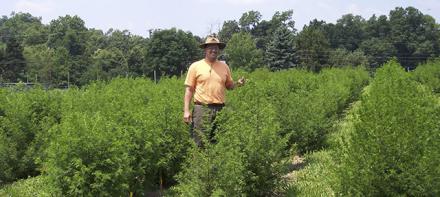Plant Packs More Punch Against Malaria

Plant physiologist Jorge Ferreira stands in an ARS research plot of Artemisia annua in West Virginia in 2005. These plants were the precursors for the high-artemisinin clones recently released to the public for further research. (D4356-1)
Plants have been used to treat illness throughout human history. For example, the active ingredient in aspirin, salicylic acid, came from white willow bark; the anticancer drug Taxol was discovered in the Pacific yew tree; and quinine, used for centuries to treat malaria, was made from the bark of the cinchona tree.
Over years of heavy use, however, quinine and its synthetic versions, such as chloroquine, became less effective as the malaria-causing parasite Plasmodium falciparum developed resistance. New therapies were needed as malaria incidence increased. More than 220 million cases of malaria were reported worldwide in 2018, according to the World Health Organization. In the United States, approximately 2,000 cases are diagnosed every year, according to the Centers for Disease Control and Prevention.
Fortunately, Nature provided another plant that can fight malaria: Artemisia annua. The plant is the only commercial source of artemisinin, the raw material used to manufacture artemisinin-combination therapies, which today are recommended by the World Health Organization as the first line of defense against malaria.
Agricultural Research Service (ARS) plant physiologist Jorge Ferreira has spent many years studying Artemisia and artemisinin. His research with collaborators recently culminated in the release of four new A. annua plant clones with twice the amount of artemisinin than current commercial plants. “This is important because both synthetic and semi-synthetic artemisinin still cost more to make than the natural one extracted from the plant, so plants are the only current viable source of it,” said Ferreira. The research team from ARS and Purdue University released the clones for free use by researchers and breeders, and the work was published in HortScience in 2019.
Ferreira is currently with ARS’s U.S. Salinity Laboratory in Riverside, CA. But before that, he was with the now-closed ARS Appalachian Farming Systems Research Center in West Virginia. There, he selected A. annua plants with high levels of artemisinin as potential treatments for livestock parasitic diseases. He sent his best material to collaborators at Purdue University and the University of Georgia for further field selection, which ultimately resulted in the four clones recently released. He also developed a laboratory method (HPLC) that directly quantifies artemisinin and its precursors in plants and in artemisinin-derived drugs, and an ELISA assay further adapted by a British company as a field test kit.
Said Ferreira, “I grew up in northern Brazil in a state then plagued by malaria, so this plant for me was a strong call to develop my Ph.D. research and expand it in other unforeseen directions during my research life at ARS.” He is quick to credit his collaborators in the United States and other countries, as well as the Chinese scientist You-You Tu, who blazed the trail for artemisinin research in the late 1960s. She received the 2015 Nobel Prize in Physiology or Medicine for her pioneering work.
Ferreira sees potential for growing A. annua in the United States (it is mainly grown in China, and some in Africa). He served as a consultant to the University of Kentucky when it began exploring production of Artemisia in fields previously planted to tobacco. If this research is successful, it could open new possibilities for U.S. production of this vital medicinal plant.—By Sue Kendall, ARS Office of Communications.
Update: On May 26, 2020, the U.S. Food and Drug Administration announced its approval of the antimalarial drug artesunate for injection to treat severe malaria in adult and pediatric patients. Artesunate is the only drug approved to treat severe malaria in the United States, and artemisinin is the raw material used to produce it.

